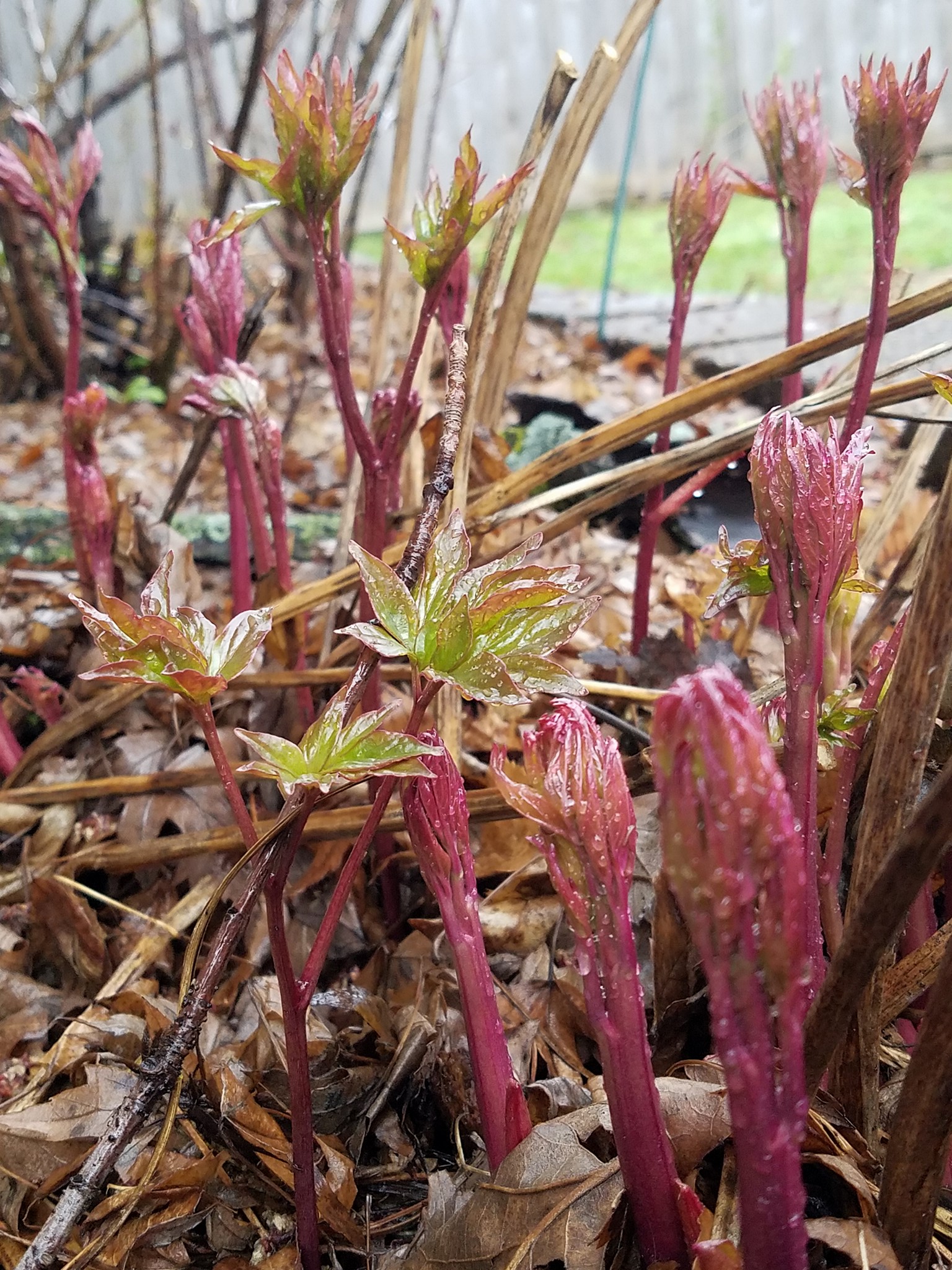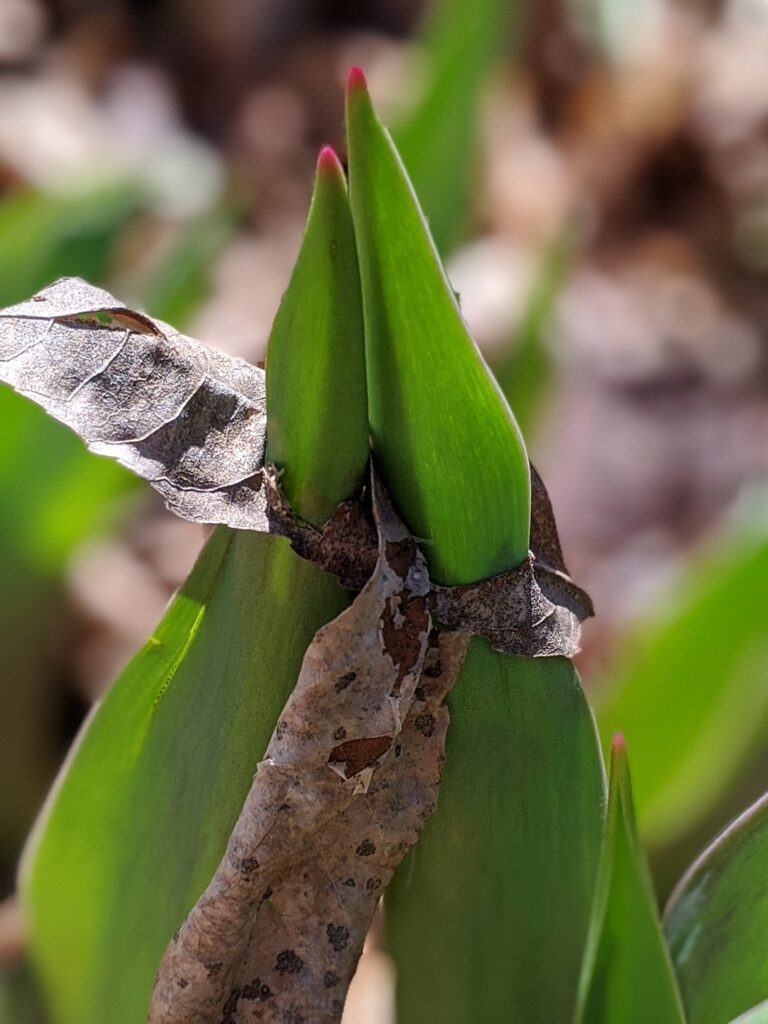
Tiny dramas
Taking a morning round through a garden is one of the small, perfect pleasures in life. It is a ritual that feels more necessary than ever, this spring, as balm in a deeply pained world. Just last week, I began again to carry my coffee onto the back porch—mug warming my hands as I peered over the railings—and then to wander in search of tiny unfurling plants. It is still not quite warm enough in Minnesota to rake out the layer of leaf mulch, and yet, there the leaflings are—variously impudent, modest, fervently glossy, as if the mere process of growing has a personality. If you follow suit in your own yard (or a friend’s), you may be surprised to find yourself whispering “you can do it” to small, stretching things. This is just what happens.
I instinctively greet emerging, lavender-tipped spikes in that high, soft voice reserved for babies and old friends. Every single year, I marvel anew that the slow pace of a sprouting tulip contains enough force to pierce last year’s fallen leaves. Once, I heard my teenaged daughter spontaneously elongate a “he-llooooooo,” the word tinged with gentle surprise as she revealed a fiddlehead of fern while clearing away leaf litter. I do not think she learned the voice, the greeting, from me; my morning forays are solitary. I think that humans cannot help themselves from occasionally murmuring aloud to their plants.
Two Junes ago, I planted the most glorious astilbe I’ve ever seen. It had tall fronds of creamy flowers, heavy with a honey-sweet scent. It wilted disastrously. No amount of coaxing could keep it from floundering. Determined the second year would be different, I scrutinized it for days, glumly watching new leaves become dry-edged despite my efforts. And then, finally, I saw it. This square foot of my shady backyard bed sits precisely where the curve of the silver maple’s branches, eighty feet above, lets in a small beam of direct morning sun. My astilbe, it turns out, loathes the spotlight. And so I resituated it over by the fence, saving the plant at the expense of my careful juxtaposition of fine astilbe sprays in front of heavy peony leaves.
Peonies don’t strike most people as background plants. Their buds swell slowly for weeks, then burst into a froth of petals in a single day. Dramatic, perfumed confections, they nonetheless strike me as unpretentious. Stems too slender to hold up their enormous heads bow nearly to the ground, assuming a midwestern posture of resolute modesty. The early blooms are notoriously short-lived, as if they wouldn’t want to impose their lushness too long upon your eye. At the height of their glory, they can be completely battered by a single heavy rainfall. Hence, in my garden, the huge bushes spend most of the summer as a deep green backdrop for the more delicate company of summer blooms.
It has taken years of trial and error, including some flailing-plant mysteries I could never solve, to realize that gardening is equal parts predictability and mercurial defiance. Best-laid plans may be thwarted by sun-spotlights or bee balm that spreads too rampantly. (Uncontained, it always spreads too rampantly.) Rabbits, it turns out, have teeth that slice through young rose canes like a knife, and dogs do not distinguish areas as “flower beds: keep out” just because the snow has melted.
Ongoing feuds with the rabbits notwithstanding, I find myself drawn to the ways that my garden daily reminds me to hold more loosely, to embrace unpredictability. The peonies flourished in the wake of the punishingly long deep freeze of 2018. Their profusion was less metaphor of resilience (after all, they adored the polar vortex that the rest of us merely endured) than exemplar of the rewards of leaning into rhythms I cannot control. Last year, my honey locust tree was strangling on its own roots. Its removal abruptly plunged a dappled bed into full sun; only two weeks in, one struggling hydrangea began perking up. And so I spent the rest of the summer just watching instead of racing to replace it.
Watching, whispering, waiting. These are the secret tools of the gardener.
In northern climates, we elongate time by treating our abbreviated growing season as a period for slow looking. But in any zone, that mode of watching is an available form of delight: to appreciate the peonies not only at the height of their lavish blooms but also when their stout, red stems first emerge, miniature forests with clutched, saw-toothed leaves shivering in cold spring rain. Every garden—whether a country acre, a semi-urban cottage plot, or a dozen planters arrayed on an urban fire escape—repays precise attention with tiny dramas. In July, the clematis flowers do not identically fade. The ones with indigo blooms on low bushes become small, downy puffs of white; pink trumpets perched on high vines turn to green-brown threads, sculptural when backlit. There is something nourishing about resisting the frenetic pace of paid work, and the demands of parenting, with such quiet views.
I find it almost impossible to quiet my mind enough to meditate, but my morning rambles help me nurture a meditative gaze. There is solace in this modest, iterative practice and the ways it promotes contemplation. And there is joy the fact that gardens do not perpetually demand to be taken seriously. One week every summer, the beds along my front porch looks like something designed by Dr. Seuss. Every flower—bee balm, sea holly, tiger lilies—sports what can only be described as crazy hairdos of bloom. If plants could make jokes, you would swear the spiky brilliance of their petals was tipped with laughter instead of just sunlight against deep shadows of evergreen. In such moments, it is impossible not to appreciate the blissful fact that gardening is the opposite of suburban lawn maintenance. Where the Homeowners Association stipulates lush, monoculture carpets—immaculately weed-treated and manicured to match your neighbors’—garden care is not keyed to narrow standards of perfection. It celebrates bad hair days.
Non-gardeners may look askance at those of us who whisper endearments and encouragements to our plants and attend to our gardens’ changes as if they are shifting moods. And while it may be healthy to channel our stressors into physical labor on behalf of floral glories, anthropomorphizing plants is simultaneously inevitable and pointless. For flowers are unselfconscious in their own magnificence. They may be extravagant tree peonies or modest forget-me-nots, sturdy and reliable phlox or cheerful coreopsis, but those are all adjectives that we put onto them. As flowers, they simply are.
We may eagerly anticipate their bloom, and lament their fade, but to view a garden exclusively in those terms is, I have some to see, a failure to think beyond uniquely human notions of success. Gardens are reminders that if you are waiting for something specific to happen, you are missing out. Wild, ornate, orderly, or fanciful, they will not always give us what we plan. Instead, they offer a chance to cultivate slower manners of being. To celebrate incremental change. To savor impermanence as a species of wonder.
Andrea Kaston Tange gardens in St. Paul, MN (zone 4b).
